
Sagitta is a dim but distinctive constellation in the northern sky. Its name is Latin for 'arrow', not to be confused with the significantly larger constellation Sagittarius 'the archer'. It was included among the 48 constellations listed by the 2nd-century astronomer Ptolemy, and it remains one of the 88 modern constellations defined by the International Astronomical Union. Although it dates to antiquity, Sagitta has no star brighter than 3rd magnitude and has the third-smallest area of any constellation.

GK Persei was a bright nova first observed on Earth in 1901. It was discovered by Thomas David Anderson, an Edinburgh clergyman, at 02:40 UT on 22 February 1901 when it was at magnitude 2.7. It reached a maximum magnitude of 0.2, the brightest nova of modern times until Nova Aquilae 1918. After fading into obscurity at about magnitude 12 to 13 during the early 20th century, GK Persei began displaying infrequent outbursts of 2 to 3 magnitudes. Since about 1980, these outbursts have become quite regular, typically lasting about two months and occurring about every three years. Thus, GK Persei seems to have changed from a classical nova like Nova Aquilae 1918 to something resembling a typical dwarf nova-type cataclysmic variable star.
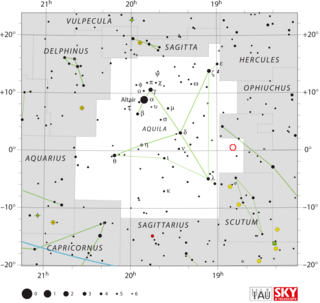
V603 Aquilae was a bright nova first observed in the constellation Aquila in 1918. It was the brightest "new star" to appear in the sky since Kepler's Supernova in 1604. Like all novae, it is a binary system, comprising a white dwarf and donor low-mass star in close orbit to the point of being only semidetached. The white dwarf sucks matter off its companion, which has filled its Roche lobe, onto its accretion disk and surface until the excess material is blown off in a thermonuclear event. This material then forms an expanding shell, which eventually thins out and disappears.

T Coronae Borealis, is a recurring nova in the constellation Corona Borealis. It was first discovered in outburst in 1866 by John Birmingham, although it had been observed earlier as a 10th magnitude star.

Theta Apodis is a variable star in the southern circumpolar constellation of Apus. It is a variable star with an apparent visual magnitude range of 4.65 to 6.20, which, according to the Bortle Dark-Sky Scale, means it is a faint star but visible to the naked eye from dark suburban skies. The distance to Theta Apodis is approximately 350 light-years, based upon parallax measurements made from the Gaia telescope. It is unusual in that it is a red star with a high proper motion.

V376 Carinae is a binary star system in the southern constellation of Carina. It has the Bayer designation b1 Carinae; V376 Carinae is the variable star designation. The system is visible to the naked eye as a faint point of light with a combined apparent magnitude of +4.69. The distance to this system from the Sun is approximately 650 light years based on parallax. It is drifting further away with a radial velocity of +27 km/s.

A luminous red nova is a stellar explosion thought to be caused by the merging of two stars. They are characterised by a distinct red colour, and a light curve that fades slowly with resurgent brightness in the infrared. Luminous red novae are not related to standard novae, which are explosions that occur on the surface of white dwarf stars.

Gamma Microscopii is the brightest star in the faint southern constellation of Microscopium. It has an apparent visual magnitude of 4.68, which is too dim to be viewed from city skies. The distance to this star has been determined using parallax measurements made with the Gaia telescope, which place it at 223 ± 8 light-years.
The Kepler Input Catalog is a publicly searchable database of roughly 13.2 million targets used for the Kepler Spectral Classification Program (SCP) and Kepler.
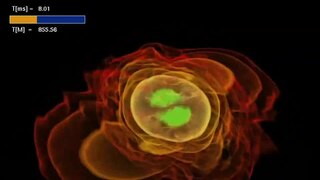
A stellar collision is the coming together of two stars caused by stellar dynamics within a star cluster, or by the orbital decay of a binary star due to stellar mass loss or gravitational radiation, or by other mechanisms not yet well understood.

NR Canis Majoris is a binary star system in the southern constellation of Canis Major, located to the east of Sirius and Gamma Canis Majoris near the constellation border with Puppis. It has a yellow-white hue and is dimly visible to the naked eye with a combined apparent visual magnitude that fluctuates around 5.60. It is located at a distance of approximately 297 light years from the Sun based on parallax. The system is drifting closer to the Sun with a radial velocity of −29 km/s, and in about three million years it is predicted to approach within 14.1+4.7
−4.0 ly. At that time, the star will become the brightest in the night sky, potentially reaching magnitude −0.88.

UY Scuti (BD-12°5055) is an extreme red hypergiant or red supergiant star in the constellation Scutum. It is considered one of the largest known stars by radius and is also a pulsating variable star, with a maximum brightness of magnitude 8.29 and a minimum of magnitude 10.56. It has an estimated radius of 1,708 solar radii (1.188×109 kilometres; 7.94 astronomical units), thus a volume nearly 5 billion times that of the Sun. It is approximately 2.9 kiloparsecs (9,500 light-years) from Earth. If placed at the center of the Solar System, its photosphere would at least engulf the orbit of Jupiter.
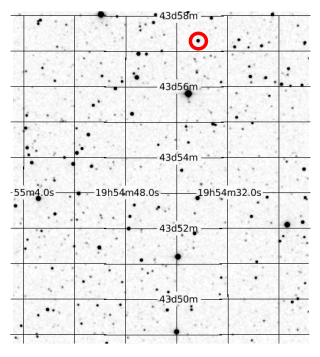
Kepler-186 is a main-sequence M1-type dwarf star, located 178.5 parsecs away in the constellation of Cygnus. The star is slightly cooler than the sun, with roughly half its metallicity. It is known to have five planets, including the first Earth-sized world discovered in the habitable zone: Kepler-186f. The star hosts four other planets discovered so far, though they all orbit interior to the habitable zone.

Tabby's Star is an F-type main-sequence star in the constellation Cygnus approximately 1,470 light-years from Earth. A distant red dwarf companion has been reported, making Tabby's Star a binary stellar system.
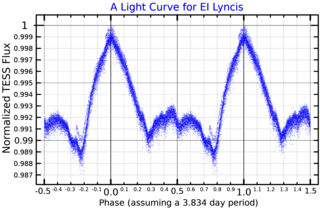
36 Lyncis is a solitary variable star located around 620 light years away from the Sun in the northern constellation of Lynx. It has the variable star designation of EI Lyncis, while 36 Lyncis is the Flamsteed designation. This object is visible to the naked eye as a dim, blue-white hued star with an apparent visual magnitude of 5.30. It is moving further away from the Earth with a heliocentric radial velocity of 21 km/s.
V1309 Scorpii is a contact binary that merged into a single star in 2008 in a process known as a luminous red nova. It was the first star to provide conclusive evidence that contact binary systems end their evolution in a stellar merger. Its similarities to V838 Monocerotis and V4332 Sagittarii allowed scientists to identify these stars as merged contact binaries as well.
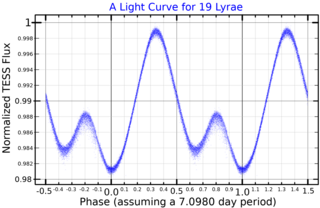
19 Lyrae is a single variable star located approximately 950 light years away from the Sun in the northern constellation of Lyra. It has the variable star designation V471 Lyr, while 19 Lyrae is the Flamsteed designation. This object is just bright enough to be visible to the naked eye, appearing as a dim, blue-white star with a baseline apparent visual magnitude of 5.93. It is moving closer to the Earth with a heliocentric radial velocity of −30 km/s, and may come as close as 167 light-years around 8.5 million years from now.
KIC 11145123, is a white hued star located in the northern constellation Cygnus, the swan. It has an apparent magnitude of 13.12, making it readily visible in large telescopes, but not to the naked eye. The object is located relatively far at a distance of approximately 3,910 light years, but is rapidly approaching the Solar System with a radial velocity of −136 km/s.
















